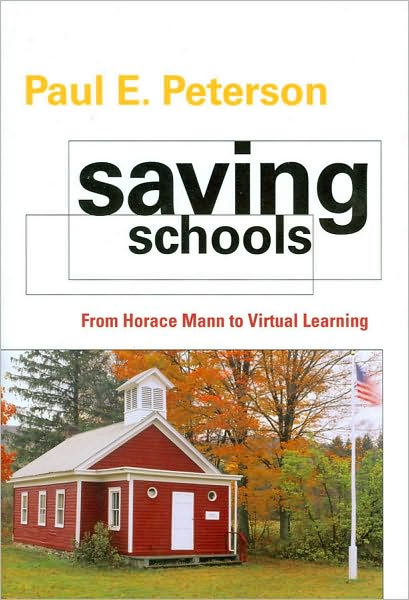I purchased Peterson’s book Saving Schools: From Horace Mann to Virtual Learning after a recommendation on some web site I have long since forgotten. What I remember from that recommendation was that this particular book provided a unique interpretation on the history of education and used that interpretation to provide some information regarding a promising direction for the future of education. I was disappointed. This book basically bends educational history to serve the purposes of making the conservative, right-wing educational agenda pushed by the Hoover Institute look like the only effective way to make education better. Its sympathies with pro-voucher, anti-teacher union rhetoric, and the non-professionalization of education bleed through every word in the book. He divides the book into three parts: 1) The Rise, 2) The Decline, and 3) Signs of Resurrection. It is not difficult for someone who is familiar with all the education propaganda being thrown about by the Hoover Institute, to guess which chapters are placed in which parts of the book. There are a total of eleven chapters in the book with each chapter basically focusing on historical educational figures of note who according to Peterson significantly influenced the development of the American education system. His placement of Horace Mann, John Dewey, and Martin Luther King Jr. in Part I The Rise, is an indication of Peterson’s belief of the positive effect these individuals had on the development of our current education system.
It is in Part II where Peterson starts blaming the decline of our education system on four things. He blames an increasingly litigious society that is basically lawsuit-happy that demands from the education system rights and opportunities due them. He describes the American Civil Liberties Union as a key boogey man in this problem, which is not surprising since this organization is on just about every right-wing organization’s target list. The next thing Peterson blames are teacher unions. According to Peterson’s argument, their efforts to fight for small class sizes, competitive salaries and better working conditions have basically robbed the education system of monetary resources that could better be spent elsewhere. It does not take a rocket-scientist to take Peterson’s argument to the next level, “The teacher unions and organizations in their efforts to selfishly satisfy their needs have deprived children of resources that could have made them successful.” This Hooverian-right-wing statement isn’t surprising at all. For the Hoover Institute to get its way with vouchers, the biggest obstacle to their adoption must be removed and that obstacle is teacher unions. Peterson just uses historical context here to push the same old tired right-wing agenda.
The third thing Peterson blames for the decline of the American education system is the push for more education funding through political channels and through litigation. He states the same old argument often coming from right-wing groups, “We have poured all this additional money into American education and all we have gotten is declining performance.” Using statistics Peterson discusses how labor-intensive education has become. According to him, schools have been adding teachers to decrease class size and adding non-teaching positions which has only served to increase the cost of personnel in the schools. Add to this the increase in the number of those who are seeking equity and adequacy through litigation. My impression from Peterson’s book is that old Hooverian tenet, “Funding is not the problem with schools; they have enough money, but they are just not spending it wisely.”
The final thing Peterson blames for the decline of the American system of education is the accountability movement combined with the excellence movement. Accountability and excellence has basically failed because there is no agreement on standards necessary for true accountability, and minus any serious efforts to institute school choice offering parents alternatives, excellence in schools never happened.
In Part Three entitled Signs of Resurrection, Peterson very predictably describes his great hopes for school reform and just as predictably all of them are tied to school choice. He idolizes the research of James Coleman and the charter school movement. In the end, he holds technology and Florida’s Virtual Public School up as having the potential of finally bringing about the kinds of reform he and his fellows at the Hoover Institute would like to see.
In the end, this book was a big disappointment. What could have been an interesting, concise look at school reform history, and possibly some unique, interesting ideas on where it could possibly be going, ended up being just another book of propaganda pushing the ideas of the Hoover Institute. To be honest, I should not really be surprised at all. Those at the Hoover Institute will do anything to bring about the kind of change they want, whether it’s describing research findings deceptively in their favor, or bending the facts of history to match political views.But the truth is, for the 21st century administrator looking for innovative solutions, Saving Schools offers no new ideas at all.

No comments:
Post a Comment